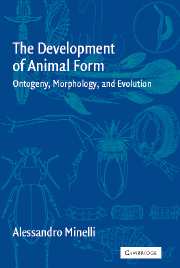Book contents
- Frontmatter
- Contents
- Preface
- Acknowledgements
- 1 The Nature of Development
- 2 Everything Begun to the Service of Development: Cellular Darwinism and the Origin of Animal Form
- 3 Development: Generic to Genetic
- 4 Periodisation
- 5 Body Regions: Their Boundaries and Complexity
- 6 Differentiation and Patterning
- 7 Size Factors
- 8 Axes and Symmetries
- 9 Segments
- 10 Evo-devo Perspectives on Homology
- Summary and Conclusions
- References
- Index
9 - Segments
Published online by Cambridge University Press: 10 August 2009
- Frontmatter
- Contents
- Preface
- Acknowledgements
- 1 The Nature of Development
- 2 Everything Begun to the Service of Development: Cellular Darwinism and the Origin of Animal Form
- 3 Development: Generic to Genetic
- 4 Periodisation
- 5 Body Regions: Their Boundaries and Complexity
- 6 Differentiation and Patterning
- 7 Size Factors
- 8 Axes and Symmetries
- 9 Segments
- 10 Evo-devo Perspectives on Homology
- Summary and Conclusions
- References
- Index
Summary
Segment identity is a subjective concept that originates from the observation that in a particular species, a number of cell characteristics are always associated in a given segment.
J. Castelli-Gair 1998: 441What Is a Segment?
From a developmental point of view, segments are something different from the modular building blocks we are used to seeing in millipedes, earthworms, and caterpillars. Generally, we regard segments as modules of body architecture advantageous to, and perhaps evolved ‘in view of’, some advanced mechanisms of locomotion. In this chapter, I will suggest a very different perspective. Basic to reformulation of our views about segments is the appreciation that this term has been and is still currently applied to many (perhaps too many) different kinds of units (Minelli and Fusco 1995).
Segments are often skeletomuscular units used in locomotory mechanics. Segments are also those units, often quite well circumscribed, that behave (or seem to behave) as convenient homologues in comparative anatomy, even if the traditionally held principle – that segments should correspond to (pairs of) coelomic pouches – suffers too many exceptions. Segments are also developmental units, whose nature, origin, and evolutionary potential are the subject of this chapter.
There is nothing wrong with identifying segments with anatomical or functional units, or in describing segmentation as a kind of symmetry (Beklemishev 1969) or, more precisely, as translational symmetry (Coen 1999, Fusco and Minelli 2000b).
- Type
- Chapter
- Information
- The Development of Animal FormOntogeny, Morphology, and Evolution, pp. 188 - 221Publisher: Cambridge University PressPrint publication year: 2003



